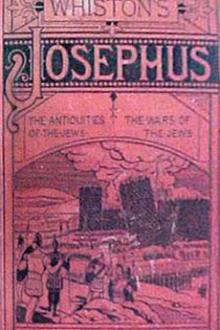judaism by shawnti (books for new readers .txt) 📖

Download in Format:
- Author: shawnti
Book online «judaism by shawnti (books for new readers .txt) 📖». Author shawnti
1990 to 5.1 million in 2001. This is indicative of the general population trends among the Jewish community in the Diaspora, but a focus on total population obscures growth trends in some denominations and communities, such as Haredi Judaism. The Baal teshuva movement is a movement of Jews who have "returned" to religion or become more observant.
Judaism and other religionsChristianity and JudaismMain article: Christianity and Judaism
See also: Judeo-Christian, Christianity and antisemitism, Judaism's view of Jesus, Cultural and historical background of Jesus, and Christian-Jewish reconciliation
This section requires expansion.
Historians and theologians regularly review the changing relationship between some Christian groups and the Jewish people; the article on Christian-Jewish reconciliation studies one recent issue.
Islam and JudaismMain article: Islam and Judaism
See also: History of the Jews under Muslim rule and Islam and antisemitism
The relationship between Islam and Judaism is special and close. Both religions claim to arise from the patriarch Abraham, and are therefore considered Abrahamic religions. As fellow monotheists, Muslims view Jews as "people of the book", a term that Jews have subsequently adopted as a way of describing their own connection to the Torah and other holy texts. In turn, many Jews maintain that Muslims adhere to the Seven Laws of Noah. Thus, Judaism views Muslims as righteous people of God.Jews have interacted with Muslims since the 7th century, when Islam originated and spread in the Arabian peninsula, and many aspects of Islam's core values, structure, jurisprudence and practice are based on Judaism. Muslim culture and philosophy have heavily influenced practitioners of Judaism in the Islamic world.
In premodern Muslim countries, Jews rarely faced martyrdom, exile or forcible conversion, and were mostly free in their choice of residence and profession. Indeed, the years 712 to 1066 CE under the Ummayad and the Abbasid rulers have been called the Golden age of Jewish culture in Spain. Non-Muslim monotheists living in these countries, including Jews, were known as dhimmis. Dhimmis were allowed to practice their religion and to administer their internal affairs, but they were subject to certain restrictions that were not imposed on Muslims. For example, they had to pay the jizya, a per capita tax imposed on free adult non-Muslim males, and they were also forbidden to bear arms or testify in court cases involving Muslims. Many of the laws regarding dhimmis were highly symbolic. For example, dhimmis in some countries were required to wear distinctive clothing, a practice not found in either the Qur'an or hadiths but invented in early medieval Baghdad and inconsistently enforced. Jews in Muslim countries were not entirely free from persecution—for example, many were killed, exiled or forcibly converted in the 12th century, in Persia and by the rulers of the Almohad dynasty in North Africa and Al-Andalus. At times, Jews were also restricted in their choice of residence—in Morocco, Jews were confined to walled quarters (mellahs) beginning in the 15th century and increasingly since the early 19th century.
In the late 20th century, Jews were expelled from nearly all the Arab countries. Most have chosen to live in Israel. Today, antisemitic themes have become commonplace in the propaganda of Arab Islamic movements such as Hizbullah and Hamas, in the pronouncements of various agencies of the Islamic Republic of Iran, and even in the newspapers and other publications of Refah Partisi.
Syncretic movements incorporating JudaismThere are some movements that combine elements of Judaism with those of other religions. The most well-known of these is Messianic Judaism, which arose in the 1960s It blends evangelical Christian theology with elements of Jewish terminology and ritual. The movement states that Jesus is part of the Trinity, and salvation is only achieved through acceptance of Jesus as one's savior. Some members of the movement are ethnically Jewish, and some of them argue that Messianic Judaism is a sect of Judaism. Jewish organizations and religious movements reject this, stating that Messianic Judaism is a Christian sect. The most controversial of these groups is the American organization Jews for Jesus, which actively proselytizes ethnic Jews through numerous missionary campaigns in major American cities.
Other examples of syncretism include Judeo-Paganists, a loosely organized set of Jews who incorporate pagan or Wiccan beliefs with some Jewish religious practices, like Messianic Judaism; Jewish Buddhists, another loosely organized group that incorporates elements of Asian spirituality in their faith; and some Renewal Jews who borrow freely and openly from Buddhism, Sufism, Native American religion, and other faiths.
The Kabbalah Centre, which employs teachers from multiple religions, is a New Age movement that claims to popularize the kabbalah, the Jewish esoteric tradition
Imprint
Judaism and other religionsChristianity and JudaismMain article: Christianity and Judaism
See also: Judeo-Christian, Christianity and antisemitism, Judaism's view of Jesus, Cultural and historical background of Jesus, and Christian-Jewish reconciliation
This section requires expansion.
Historians and theologians regularly review the changing relationship between some Christian groups and the Jewish people; the article on Christian-Jewish reconciliation studies one recent issue.
Islam and JudaismMain article: Islam and Judaism
See also: History of the Jews under Muslim rule and Islam and antisemitism
The relationship between Islam and Judaism is special and close. Both religions claim to arise from the patriarch Abraham, and are therefore considered Abrahamic religions. As fellow monotheists, Muslims view Jews as "people of the book", a term that Jews have subsequently adopted as a way of describing their own connection to the Torah and other holy texts. In turn, many Jews maintain that Muslims adhere to the Seven Laws of Noah. Thus, Judaism views Muslims as righteous people of God.Jews have interacted with Muslims since the 7th century, when Islam originated and spread in the Arabian peninsula, and many aspects of Islam's core values, structure, jurisprudence and practice are based on Judaism. Muslim culture and philosophy have heavily influenced practitioners of Judaism in the Islamic world.
In premodern Muslim countries, Jews rarely faced martyrdom, exile or forcible conversion, and were mostly free in their choice of residence and profession. Indeed, the years 712 to 1066 CE under the Ummayad and the Abbasid rulers have been called the Golden age of Jewish culture in Spain. Non-Muslim monotheists living in these countries, including Jews, were known as dhimmis. Dhimmis were allowed to practice their religion and to administer their internal affairs, but they were subject to certain restrictions that were not imposed on Muslims. For example, they had to pay the jizya, a per capita tax imposed on free adult non-Muslim males, and they were also forbidden to bear arms or testify in court cases involving Muslims. Many of the laws regarding dhimmis were highly symbolic. For example, dhimmis in some countries were required to wear distinctive clothing, a practice not found in either the Qur'an or hadiths but invented in early medieval Baghdad and inconsistently enforced. Jews in Muslim countries were not entirely free from persecution—for example, many were killed, exiled or forcibly converted in the 12th century, in Persia and by the rulers of the Almohad dynasty in North Africa and Al-Andalus. At times, Jews were also restricted in their choice of residence—in Morocco, Jews were confined to walled quarters (mellahs) beginning in the 15th century and increasingly since the early 19th century.
In the late 20th century, Jews were expelled from nearly all the Arab countries. Most have chosen to live in Israel. Today, antisemitic themes have become commonplace in the propaganda of Arab Islamic movements such as Hizbullah and Hamas, in the pronouncements of various agencies of the Islamic Republic of Iran, and even in the newspapers and other publications of Refah Partisi.
Syncretic movements incorporating JudaismThere are some movements that combine elements of Judaism with those of other religions. The most well-known of these is Messianic Judaism, which arose in the 1960s It blends evangelical Christian theology with elements of Jewish terminology and ritual. The movement states that Jesus is part of the Trinity, and salvation is only achieved through acceptance of Jesus as one's savior. Some members of the movement are ethnically Jewish, and some of them argue that Messianic Judaism is a sect of Judaism. Jewish organizations and religious movements reject this, stating that Messianic Judaism is a Christian sect. The most controversial of these groups is the American organization Jews for Jesus, which actively proselytizes ethnic Jews through numerous missionary campaigns in major American cities.
Other examples of syncretism include Judeo-Paganists, a loosely organized set of Jews who incorporate pagan or Wiccan beliefs with some Jewish religious practices, like Messianic Judaism; Jewish Buddhists, another loosely organized group that incorporates elements of Asian spirituality in their faith; and some Renewal Jews who borrow freely and openly from Buddhism, Sufism, Native American religion, and other faiths.
The Kabbalah Centre, which employs teachers from multiple religions, is a New Age movement that claims to popularize the kabbalah, the Jewish esoteric tradition
Imprint
Text: facts about and history about judaism
Publication Date: 12-04-2011
All Rights Reserved
Free ebook «judaism by shawnti (books for new readers .txt) 📖» - read online now
Similar e-books:





Comments (0)